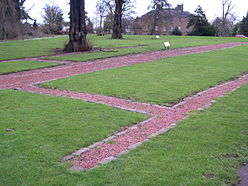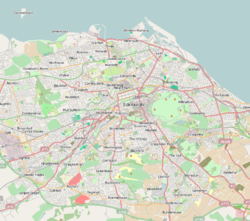Cramond Roman Fort
| Cramond Roman Fort | |
|---|---|

Site of the Roman fort at Cramond
|
|
| Alternative name(s) | Carumabo?, Rumabo? |
| Founded | c. 140 AD |
| Abandoned | 4th century AD |
| Attested by | Ravenna Cosmography? |
| — Legions — | |
| vexill. II Augusta | |
| — Cohorts — | |
| Coordinates | 55°58′39″N 3°17′48″W / 55.9774°N 3.2967°W |
| Town | Edinburgh |
| Country | Scotland |
| UK-OSNG reference | NT1976 |
Cramond Roman Fort is a Roman-Era archaeological site at Cramond, Edinburgh, Scotland. The settlement may be the "Rumabo" listed in the 7th-century Ravenna Cosmography. The fort was established around 140 AD and occupied until around 170, with a further period of occupation from around 208 to 211. Among the many archaeological finds, one of the most famous is a sculpture known as the Cramond Lioness.
The fort at Cramond was located on the River Almond at the point where it flows into the Forth. In Roman times, there was probably a natural harbour here. The fort was established around 140 during the building of the Antonine Wall, and remained in use until around 170 when the Romans retreated south to Hadrian's Wall. When the Roman Emperor Septimius Severus began the last major Roman incursion into Scotland from 208 to 211, the fort was reoccupied and enlarged. Throughout these periods of occupation a civilian settlement seems to have existed outside the fort, and some native occupation of the fort seems to have taken place after the time of Severus into the 4th century.
A stone altar which was dug up a few hundred years ago in the grounds of Cramond House, was originally erected by a cohort of Tungrians (either first or second) and was dedicated to "the Alatervan Mothers and the Mothers of the Parade-ground" (Latin: Matres Alatervae et Matres Campestres). Early antiquarians interpreted this as referring to the place where the stone was found, and drew from it the conclusion that the Roman name of Cramond was "Alaterva". This idea is no longer accepted among scholars, and "Alatervae" is now believed to be an epithet attached to the Matronae, following a practice found elsewhere in the empire. It is thought that Cramond may be the "Rumabo" listed in the 7th-century Ravenna Cosmography – the original form of the name perhaps being "Carumabo".
...
Wikipedia

